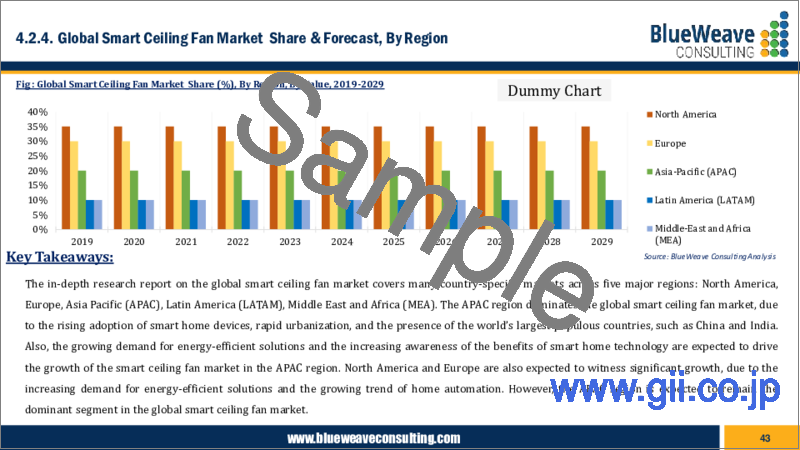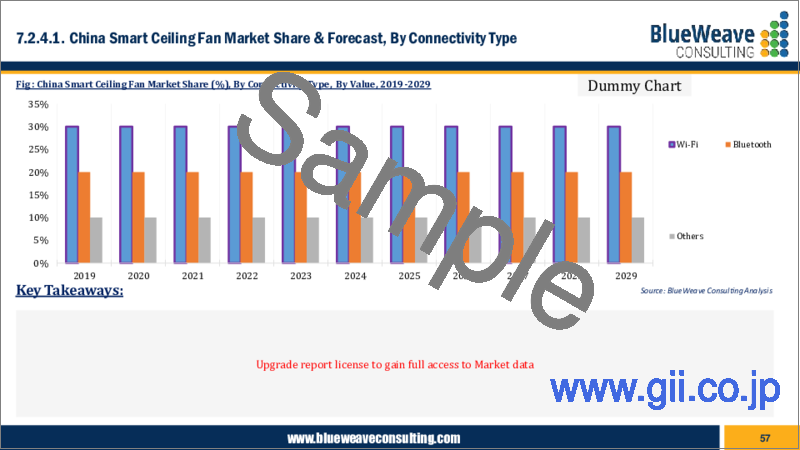|
|
市場調査レポート
商品コード
1274840
スマートシーリングファンの世界市場 - 市場規模、シェア、動向分析、機会、予測:接続タイプ別、スイープサイズ別、エンドユーザー別、地域別(2019年~2029年)Smart Ceiling Fan Market - Global Size, Share, Trend Analysis, Opportunity and Forecast Report, 2019-2029, Segmented By Connectivity Type ; By Sweep Size ; By End User ; By Region |
||||||
|
|||||||
| スマートシーリングファンの世界市場 - 市場規模、シェア、動向分析、機会、予測:接続タイプ別、スイープサイズ別、エンドユーザー別、地域別(2019年~2029年) |
|
出版日: 2023年05月11日
発行: Blueweave Consulting
ページ情報: 英文 400 Pages
納期: 2~3営業日
|
- 全表示
- 概要
- 目次
世界のスマートシーリングファンの市場規模は、2022年の5,700億米ドルから、2029年までに7,913億9,000万米ドルに達し、2023年~2029年の間の予測期間中に4.8%のCAGRで成長すると予測されています。
世界のスマートシーリングファン市場は、エネルギー効率が高く、環境に優しい家庭用製品への需要の高まりにより拡大しています。また、スマートホームの受け入れが進み、スマートデバイスとホームオートメーションシステムが統合されたことも、分析期間中の世界のスマートシーリングファン市場を促進しています。
当レポートでは、世界のスマートシーリングファン市場について調査分析し、市場洞察、セグメント別・地域別の市場分析、競合情勢、主要企業のプロファイルなど、体系的な情報を提供しています。
目次
第1章 調査の枠組み
第2章 エグゼクティブサマリー
第3章 世界のスマートシーリングファン市場の洞察
- 業界バリューチェーン分析
- DROC分析
- 成長促進要因
- 抑制要因
- 機会
- 課題
- 製品の進歩/最近の開発
- 規制の枠組み
- ポーターのファイブフォース分析
第4章 世界のスマートシーリングファン市場概要
- 市場規模と予測(2019年~2029年)
- 金額別
- 市場シェアと予測
- 接続タイプ別
- Wi-Fi
- Bluetooth
- その他
- スイープサイズ別
- 500mm未満
- 500~999mm
- 1000~1500mm
- 1500mm超
- エンドユーザー別
- 住宅
- 商業
- その他
- 地域別
- 北米
- 欧州
- アジア太平洋(APAC)
- ラテンアメリカ(LATAM)
- 中東・アフリカ(MEA)
- 接続タイプ別
第5章 北米のスマートシーリングファン市場
- 市場規模と予測(2019年~2029年)
- 金額別
- 市場シェアと予測
- 接続タイプ別
- スイープサイズ別
- エンドユーザー別
- 国別
- 米国
- カナダ
第6章 欧州のスマートシーリングファン市場
- 市場規模と予測(2019年~2029年)
- 金額別
- 市場シェアと予測
- 接続タイプ別
- スイープサイズ別
- エンドユーザー別
- 国別
- ドイツ
- 英国
- イタリア
- フランス
- スペイン
- ベルギー
- ロシア
- オランダ
- その他欧州
第7章 アジア太平洋のスマートシーリングファン市場
- 市場規模と予測(2019年~2029年)
- 金額別
- 市場シェアと予測
- 接続タイプ別
- スイープサイズ別
- エンドユーザー別
- 国別
- 中国
- インド
- 日本
- 韓国
- オーストラリア・ニュージーランド
- インドネシア
- マレーシア
- シンガポール
- ベトナム
- その他アジア太平洋
第8章 ラテンアメリカのスマートシーリングファン市場
- 市場規模と予測(2019年~2029年)
- 金額別
- 市場シェアと予測
- 接続タイプ別
- スイープサイズ別
- エンドユーザー別
- 国別
- ブラジル
- メキシコ
- アルゼンチン
- ペルー
- その他ラテンアメリカ
第9章 中東・アフリカのスマートシーリングファン市場
- 市場規模と予測(2019年~2029年)
- 金額別
- 市場シェアと予測
- 接続タイプ別
- スイープサイズ別
- エンドユーザー別
- 国別
- サウジアラビア
- アラブ首長国連邦
- カタール
- クウェート
- 南アフリカ
- ナイジェリア
- アルジェリア
- その他中東・アフリカ
第10章 競合情勢
- 主要企業・製品一覧
- 世界のスマートシーリングファン市場シェア分析(2022年)
- 競合ベンチマーク:操作パラメータ別
- 主要な戦略的展開(合併・買収・提携など)
第11章 世界のスマートシーリングファン市場に対するCOVID-19の影響
第12章 企業プロファイル(企業概要、財務マトリックス、競合情勢、主要な人材、主要な競合、連絡先、戦略的展望、SWOT分析)
- Hunter Fan Company
- Minka Group
- Casablanca Fan Company
- Fanimation, Inc.
- Emerson Electric Co.
- Haiku Home
- Savoy House
- Vento Fans USA
- Home Decorators Collection
- Orient Electric Ltd.
- Monte Carlo Fan Company
- Progress Lighting
- Quorum International Inc.
- Westinghouse Electric Corporation
- Vaxcel International
- その他
第13章 主要な戦略的推奨事項
第14章 調査手法
Global Smart Ceiling Fan Market Size Set to Breeze at Steady CAGR of 4.8% to Reach USD 791.4 Million by 2029.
The global smart ceiling fan market is rapidly growing due to rising demand for energy-efficient and IoT-enabled devices, the increasing popularity of smart homes, and the growing adoption of home automation systems.
BlueWeave Consulting, a leading strategic consulting and market research firm, in its recent study, estimated the global smart ceiling fan market size at USD 570 billion in 2022. During the forecast period between 2023 and 2029, BlueWeave expects the global smart ceiling fan market size to grow at a CAGR of 4.8% reaching a value of USD 791.39 billion by 2029. The global smart ceiling fan market is expanding due to rising demand for energy-efficient and environmentally friendly household products. Smart ceiling fans have modern capabilities, such as voice control, Wi-Fi connectivity, and app-based control, which give users with increased convenience and customization possibilities. The growing acceptance of smart homes and the integration of smart devices with home automation systems are also driving the global smart ceiling fan market during the period in analysis.
Global Smart Ceiling Fan Market - Overview:
A smart ceiling fan is a type of ceiling fan that can be controlled remotely through a smartphone or other smart device. Smart ceiling fans are typically equipped with Wi-Fi or Bluetooth connectivity, allowing users to adjust the fan's speed, direction, and other settings using an app on their phone or through voice commands via a smart speaker. Smart ceiling fans offer a number of benefits over traditional ceiling fans. For one, they allow for greater convenience and flexibility in controlling the fan. With a smart ceiling fan, users can adjust the fan's settings from anywhere, without having to physically reach the fan or the wall switch. It can be particularly useful for those with high ceilings or for fans that are located in hard-to-reach areas. Another advantage of smart ceiling fans is that they can be integrated into a larger smart home ecosystem. For example, users can set up schedules or routines to automatically adjust the fan's settings based on the time of day, the temperature, or other environmental factors. They can also be integrated with other smart devices, such as smart thermostats or smart lighting, to create a more cohesive and efficient home automation system.
Smart ceiling fans can also help to save energy and reduce electricity costs. By allowing users to adjust the fan's speed and direction more precisely, they can help to optimize airflow and reduce the need for air conditioning or heating. Some smart ceiling fans are also equipped with sensors or other smart features that can automatically adjust the fan's settings based on the ambient temperature or humidity levels. Overall, smart ceiling fans are a convenient, flexible, and energy-efficient solution for home cooling and ventilation. With the growing popularity of smart home technology, it is likely that smart ceiling fans will witness continued innovation and development in the coming years.
Impact of COVID-19 on Global Smart Ceiling Fan Market
The COVID-19 pandemic significantly impacted the growth of the global smart ceiling fan market during 2020-2021. With lockdowns and social distancing measures in place, the demand for home automation products such as smart ceiling fans increased, but the supply chain was disrupted, causing delays in production and delivery. Also, the economic slowdown caused by the pandemic affected consumer purchasing power, resulting in a decline in demand for non-essential products, including smart ceiling fans. These factors led to a decline in sales and revenue for manufacturers in the smart ceiling fan market. Consequently, the smart ceiling industry across the globe faced challenges in the short-term.
Global Smart Ceiling Fan Market - By End User:
On the basis of end user, the global smart ceiling fan market is split into Residential and Commercial segments. The residential segment is a larger contributor to the growth of the global smart ceiling fan market. The residential segment includes households, apartments, and other residential buildings. The demand for smart ceiling fans in residential settings is increasing due to the growing trend toward smart homes and energy efficiency. Smart ceiling fans offer features, such as voice control, remote control, and integration with smart home systems, which are appealing to homeowners. Also, smart ceiling fans help reduce energy consumption and costs, making them a popular choice for eco-conscious consumers. The commercial segment includes buildings, such as offices, hotels, and retail stores, but it is a smaller segment than the residential segment.
Competitive Landscape:
The global smart ceiling fan market is significantly competitive. Major companies in the market include Casablanca Fan Company, Fanimation, Inc., Emerson Electric Co., Haiku Home, Savoy House, Vento Fans USA, Home Decorators Collection, Orient Electric Ltd., Monte Carlo Fan Company, Progress Lighting, Quorum International Inc., Westinghouse Electric Corporation, and Vaxcel International. These companies use various strategies, including increasing investments in their R&D activities, mergers, and acquisitions, joint ventures, collaborations, licensing agreements, and new product and service releases to further strengthen their position in global smart ceiling fan market.
The in-depth analysis of the report provides information about growth potential, upcoming trends, and statistics of Global Smart Ceiling Fan Market. It also highlights the factors driving forecasts of total market size. The report promises to provide recent technology trends in Global Smart Ceiling Fan Market and industry insights to help decision-makers make sound strategic decisions. Furthermore, the report also analyzes the growth drivers, challenges, and competitive dynamics of the market.
Table of Contents
1. Research Framework
- 1.1. Research Objective
- 1.2. Product Overview
- 1.3. Market Segmentation
2. Executive Summary
3. Global Smart Ceiling Fan Market Insights
- 3.1. Industry Value Chain Analysis
- 3.2. DROC Analysis
- 3.2.1. Growth Drivers
- 3.2.1.1. Increasing demand for energy-efficient appliances and smart homes
- 3.2.1.2. Growing adoption of IoT and automation technologies in residential and commercial sectors
- 3.2.1.3. Advancements in fan design and technology, leading to improved performance and convenience
- 3.2.2. Restraints
- 3.2.2.1. High cost of smart ceiling fans compared to traditional fans
- 3.2.2.2. Lack of awareness and technical knowledge among consumers in developing regions
- 3.2.3. Opportunities
- 3.2.3.1. Growing demand for voice-activated and remote-controlled appliances
- 3.2.3.2. Increasing use of AI and machine learning in fan design
- 3.2.4. Challenges
- 3.2.4.1. Concerns regarding data privacy and security with the use of smart home devices
- 3.2.1. Growth Drivers
- 3.3. Product Advancements/Recent Developments
- 3.4. Regulatory Framework
- 3.5. Porter's Five Forces Analysis
- 3.5.1. Bargaining Power of Suppliers
- 3.5.2. Bargaining Power of Buyers
- 3.5.3. Threat of New Entrants
- 3.5.4. Threat of Substitutes
- 3.5.5. Intensity of Rivalry
4. Global Smart Ceiling Fan Market Overview
- 4.1. Market Size & Forecast, 2019-2029
- 4.1.1. By Value (USD Million)
- 4.2. Market Share and Forecast
- 4.2.1. By Connectivity Type
- 4.2.1.1. Wi-Fi
- 4.2.1.2. Bluetooth
- 4.2.1.3. Others
- 4.2.2. By Sweep Size
- 4.2.2.1. Less than 500mm
- 4.2.2.2. 500-999mm
- 4.2.2.3. 1000-1500mm
- 4.2.2.4. More than 1500mm
- 4.2.3. By End Users
- 4.2.3.1. Residential
- 4.2.3.2. Commercial
- 4.2.3.3. Others
- 4.2.4. By Region
- 4.2.4.1. North America
- 4.2.4.2. Europe
- 4.2.4.3. Asia Pacific (APAC)
- 4.2.4.4. Latin America (LATAM)
- 4.2.4.5. Middle East and Africa (MEA)
- 4.2.1. By Connectivity Type
5. North America Smart Ceiling Fan Market
- 5.1. Market Size & Forecast, 2019-2029
- 5.1.1. By Value (USD Million)
- 5.2. Market Share & Forecast
- 5.2.1. By Connectivity Type
- 5.2.2. By Sweep Size
- 5.2.3. By End Users
- 5.2.4. By Country
- 5.2.4.1. United States
- 5.2.4.1.1. By Connectivity Type
- 5.2.4.1.2. By Sweep Size
- 5.2.4.1.3. By End Users
- 5.2.4.2. Canada
- 5.2.4.2.1. By Connectivity Type
- 5.2.4.2.2. By Sweep Size
- 5.2.4.2.3. By End Users
6. Europe Smart Ceiling Fan Market
- 6.1. Market Size & Forecast, 2019-2029
- 6.1.1. By Value (USD Million)
- 6.2. Market Share & Forecast
- 6.2.1. By Connectivity Type
- 6.2.2. By Sweep Size
- 6.2.3. By End Users
- 6.2.4. By Country
- 6.2.4.1. Germany
- 6.2.4.1.1. By Connectivity Type
- 6.2.4.1.2. By Sweep Size
- 6.2.4.1.3. By End Users
- 6.2.4.2. United Kingdom
- 6.2.4.2.1. By Connectivity Type
- 6.2.4.2.2. By Sweep Size
- 6.2.4.2.3. By End Users
- 6.2.4.3. Italy
- 6.2.4.3.1. By Connectivity Type
- 6.2.4.3.2. By Sweep Size
- 6.2.4.3.3. By End Users
- 6.2.4.4. France
- 6.2.4.4.1. By Connectivity Type
- 6.2.4.4.2. By Sweep Size
- 6.2.4.4.3. By End Users
- 6.2.4.5. Spain
- 6.2.4.5.1. By Connectivity Type
- 6.2.4.5.2. By Sweep Size
- 6.2.4.5.3. By End Users
- 6.2.4.6. Belgium
- 6.2.4.6.1. By Connectivity Type
- 6.2.4.6.2. By Sweep Size
- 6.2.4.6.3. By End Users
- 6.2.4.7. Russia
- 6.2.4.7.1. By Connectivity Type
- 6.2.4.7.2. By Sweep Size
- 6.2.4.7.3. By End Users
- 6.2.4.8. The Netherlands
- 6.2.4.8.1. By Connectivity Type
- 6.2.4.8.2. By Sweep Size
- 6.2.4.8.3. By End Users
- 6.2.4.9. Rest of Europe
- 6.2.4.9.1. By Connectivity Type
- 6.2.4.9.2. By Sweep Size
- 6.2.4.9.3. By End Users
7. Asia-Pacific Smart Ceiling Fan Market
- 7.1. Market Size & Forecast, 2019-2029
- 7.1.1. By Value (USD Million)
- 7.2. Market Share & Forecast
- 7.2.1. By Connectivity Type
- 7.2.2. By Sweep Size
- 7.2.3. By End Users
- 7.2.4. By Country
- 7.2.4.1. China
- 7.2.4.1.1. By Connectivity Type
- 7.2.4.1.2. By Sweep Size
- 7.2.4.1.3. By End Users
- 7.2.4.2. India
- 7.2.4.2.1. By Connectivity Type
- 7.2.4.2.2. By Sweep Size
- 7.2.4.2.3. By End Users
- 7.2.4.3. Japan
- 7.2.4.3.1. By Connectivity Type
- 7.2.4.3.2. By Sweep Size
- 7.2.4.3.3. By End Users
- 7.2.4.4. South Korea
- 7.2.4.4.1. By Connectivity Type
- 7.2.4.4.2. By Sweep Size
- 7.2.4.4.3. By End Users
- 7.2.4.5. Australia & New Zealand
- 7.2.4.5.1. By Connectivity Type
- 7.2.4.5.2. By Sweep Size
- 7.2.4.5.3. By End Users
- 7.2.4.6. Indonesia
- 7.2.4.6.1. By Connectivity Type
- 7.2.4.6.2. By Sweep Size
- 7.2.4.6.3. By End Users
- 7.2.4.7. Malaysia
- 7.2.4.7.1. By Connectivity Type
- 7.2.4.7.2. By Sweep Size
- 7.2.4.7.3. By End Users
- 7.2.4.8. Singapore
- 7.2.4.8.1. By Connectivity Type
- 7.2.4.8.2. By Sweep Size
- 7.2.4.8.3. By End Users
- 7.2.4.9. Vietnam
- 7.2.4.9.1. By Connectivity Type
- 7.2.4.9.2. By Sweep Size
- 7.2.4.9.3. By End Users
- 7.2.4.10. Rest of APAC
- 7.2.4.10.1. By Connectivity Type
- 7.2.4.10.2. By Sweep Size
- 7.2.4.10.3. By End Users
8. Latin America Smart Ceiling Fan Market
- 8.1. Market Size & Forecast, 2019-2029
- 8.1.1. By Value (USD Million)
- 8.2. Market Share & Forecast
- 8.2.1. By Connectivity Type
- 8.2.2. By Sweep Size
- 8.2.3. By End Users
- 8.2.4. By Country
- 8.2.4.1. Brazil
- 8.2.4.1.1. By Connectivity Type
- 8.2.4.1.2. By Sweep Size
- 8.2.4.1.3. By End Users
- 8.2.4.2. Mexico
- 8.2.4.2.1. By Connectivity Type
- 8.2.4.2.2. By Sweep Size
- 8.2.4.2.3. By End Users
- 8.2.4.3. Argentina
- 8.2.4.3.1. By Connectivity Type
- 8.2.4.3.2. By Sweep Size
- 8.2.4.3.3. By End Users
- 8.2.4.4. Peru
- 8.2.4.4.1. By Connectivity Type
- 8.2.4.4.2. By Sweep Size
- 8.2.4.4.3. By End Users
- 8.2.4.5. Rest of LATAM
- 8.2.4.5.1. By Connectivity Type
- 8.2.4.5.2. By Sweep Size
- 8.2.4.5.3. By End Users
9. Middle East & Africa Smart Ceiling Fan Market
- 9.1. Market Size & Forecast, 2019-2029
- 9.1.1. By Value (USD Million)
- 9.2. Market Share & Forecast
- 9.2.1. By Connectivity Type
- 9.2.2. By Sweep Size
- 9.2.3. By End Users
- 9.2.4. By Country
- 9.2.4.1. Saudi Arabia
- 9.2.4.1.1. By Connectivity Type
- 9.2.4.1.2. By Sweep Size
- 9.2.4.1.3. By End Users
- 9.2.4.2. UAE
- 9.2.4.2.1. By Connectivity Type
- 9.2.4.2.2. By Sweep Size
- 9.2.4.2.3. By End Users
- 9.2.4.3. Qatar
- 9.2.4.3.1. By Connectivity Type
- 9.2.4.3.2. By Sweep Size
- 9.2.4.3.3. By End Users
- 9.2.4.4. Kuwait
- 9.2.4.4.1. By Connectivity Type
- 9.2.4.4.2. By Sweep Size
- 9.2.4.4.3. By End Users
- 9.2.4.5. South Africa
- 9.2.4.5.1. By Connectivity Type
- 9.2.4.5.2. By Sweep Size
- 9.2.4.5.3. By End Users
- 9.2.4.6. Nigeria
- 9.2.4.6.1. By Connectivity Type
- 9.2.4.6.2. By Sweep Size
- 9.2.4.6.3. By End Users
- 9.2.4.7. Algeria
- 9.2.4.7.1. By Connectivity Type
- 9.2.4.7.2. By Sweep Size
- 9.2.4.7.3. By End Users
- 9.2.4.8. Rest of MEA
- 9.2.4.8.1. By Connectivity Type
- 9.2.4.8.2. By Sweep Size
- 9.2.4.8.3. By End Users
10. Competitive Landscape
- 10.1. List of Key Players and Their Offerings
- 10.2. Global Smart Ceiling Fan Market Share Analysis, 2022
- 10.3. Competitive Benchmarking, By Operating Parameters
- 10.4. Key Strategic Developments (Mergers, Acquisitions, Partnerships, etc.)
11. Impact of Covid-19 on Global Smart Ceiling Fan Market
12. Company Profile (Company Overview, Financial Matrix, Competitive Landscape, Key Personnel, Key Competitors, Contact Address, Strategic Outlook, SWOT Analysis)
- 12.1. Hunter Fan Company
- 12.2. Minka Group
- 12.3. Casablanca Fan Company
- 12.4. Fanimation, Inc.
- 12.5. Emerson Electric Co.
- 12.6. Haiku Home
- 12.7. Savoy House
- 12.8. Vento Fans USA
- 12.9. Home Decorators Collection
- 12.10. Orient Electric Ltd.
- 12.11. Monte Carlo Fan Company
- 12.12. Progress Lighting
- 12.13. Quorum International Inc.
- 12.14. Westinghouse Electric Corporation
- 12.15. Vaxcel International
- 12.16. Other Prominent Players
13. Key Strategic Recommendations
14. Research Methodology
- 14.1. Qualitative Research
- 14.1.1. Primary & Secondary Research
- 14.2. Quantitative Research
- 14.3. Market Breakdown & Data Triangulation
- 14.3.1. Secondary Research
- 14.3.2. Primary Research
- 14.4. Breakdown of Primary Research Respondents, By Region
- 14.5. Assumptions & Limitations





